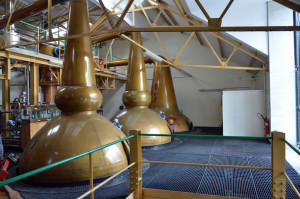By Richard Thomas
Lately the mainstream news seems to have been on a see-saw when it comes to Scotch whisky. On the uptick, it reports on how large and valuable the whisky industry is (such as it did during the September 2014 independence referendum) or on how the value of rare, collectible bottles of the stuff is at an all-time high (as it is doing now). On the downtick, it dwells on the recent slump and stagnation in overall sales.
One piece of information that belies current sales statistics and has little to do with big auction prices is the comeback of mothballed distilleries. A distillery revival is a sign that somebody thinks Scotch is looking good for years to come, since it will take that long for even the youngest product to appear on the market.
Here are four examples of Scotch distilleries that were brought back into production in recent years:
Annandale
In terms of the scale of restoration involved, Annandale has to take the cake. The distillery was founded in 1830, and was an early acquisition of the burgeoning Johnnie Walker brand, who picked it up in the 1890s. The distillery was closed in 1919, the property sold to farmers in 1924, and it has been out of the whisky trade ever since. Hence this Scottish Borders distillery was so obscure that until relatively recently only those scholars interested in relics that hadn’t operated in living memory knew anything about it.
This began to change in 2007, when David Thomson and Teresa Church formed the Annandale Distillery Company and bought the property. By then the distillery was a ruin, but by 2014 the restoration was complete. Annandale opened to visitors and filled their first casks.
Bladnoch
The return of this distillery to operation was less a matter of restoration and more one of straightening out business and finances. Bladnoch shut down production in 2009 and went into full bankruptcy in 2014, entering limbo as the owners were unable to come to an agreement on whether or not to sell the distillery and its stock. The logjam eventually gave way, Ian MacMillan has been hired to bring things back online, and Bladnoch is well on its way to producing again.
Dallas Dhu
The Dallas Dhu revival can only be classed as partial and in progress. Opened in 1899 during the original Scotch whisky boom, the distllery was shut down as part of a wave of closures in 1983. Worse was the withdrawal of its distillery license in 1992, effectively taking the distillery out of mothball and putting it in the grave insofar as whisky-making was concerned. In 1988, however, the distillery’s shutters were taken down and Dallas Dhu became a public museum.
What makes Dallas Dhu an in-progress revival is both that it’s doors are open to visitors and that it’s owners, Historic Scotland, want to restart production there. The state agency has been exploring whisky-making at Dallas Dhu to expand its appeal as a tourist attraction. After all, in 1988 few if any Scotch distilleries were really set up with tourists in mind. Now many of them are, and Dallas Dhu has plenty of competition for visitors in Speyside alone.
Glen Keith
That competition for visitors isn’t coming from Glen Keith, however, as this is one of the few distilleries in Scotland to see major investment in recent years and yet remains closed to tourists. One of the more modern foundations among Scottish distilleries, Glen Keith dates to 1958, was mothballed in 1999, and cannibalized for parts during the years that followed. Thus when Chivas Brothers decided to revive the distillery, they had to rebuild most of the machinery. Glen Keith reopened in 2013, and visitors to Keith can take a stroll around the distillery’s exterior (it’s certainly attractive), but there are no tours.
 The Whiskey Reviewer A World of Whiskey, Poured Every Weekday
The Whiskey Reviewer A World of Whiskey, Poured Every Weekday

